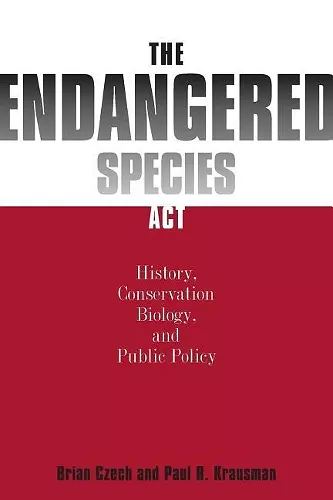The Endangered Species Act
History, Conservation Biology, and Public Policy
Brian Czech author Paul R Krausman author
Format:Paperback
Publisher:Johns Hopkins University Press
Published:14th Mar '01
Currently unavailable, and unfortunately no date known when it will be back

Czech and Krausman are effective and original scholars. The Endangered Species Act: History, Conservation Biology, and Public Policy is both a treatise on policy assessment and an excellent history, assessment, and discussion of the ESA itself. Those interested in natural resources policy and those interested specifically in the ESA will want to read this book. -- Jack Ward Thomas, The University of Montana, Chief Emeritus, U.S. Forest Service
A history and critique of the USA's Endangered Species Act (ESA). Outlining the controversies surrounding the ESA, Brian Czech and Paul R. Krausman incorporate the new model of policy design theory to frame a larger discussion about conservation biology and American democracy.Since the 1970s, the Endangered Species Act (ESA), by virtue of its regulatory impact, has been a frequent subject of policy analysis. In this comprehensive history and critique of the ESA, Brian Czech and Paul R. Krausman incorporate the new model of policy design theory to frame a larger discussion about conservation biology and American democracy. Czech and Krausman provide a historical background of endangered species policy that integrates natural history, socioeconomic trends, political movements, and professional developments. Outlining the controversies surrounding the ESA, they find a connection between challenges to species conservation and challenges to democracy. After an assessment of ESA analyses that have been performed from traditional perspectives, they engage policy design theory to review the structural logic of the ESA, analyzing each clause of the legislation for its application of the fundamental elements of democracy. To address the technical legitimacy of ESA, they propose two new genetic considerations-functional genome size and molecular clock speed-to supplement phylogenetic distinctiveness as criteria with which to prioritize species for conservation. Next, they systematically describe the socioeconomic context of ESA by assessing and classifying the causes of species endangerment. A hybrid of policy analysis and ecological assessment, The Endangered Species Act: History, Conservation Biology, and Public Policy will appeal to scholars and students in the fields of natural resource policy and law, conservation biology, political science, wildlife ecology, and environmental history, and to professionals at agencies involved in wildlife conservation.
This book is concisely written and reads easily,... uniquely covers the social and political contexts of the ESA... [and] provides insight into the controversies surrounding [it]... It provokes thoughtful consideration of the ESA, it logically organizes ESA issues, and it boldy recommends improvements. -- K. Shawn Smallwood Environmental Conservation Interesting for anyone concerned about the preservation of species and, more generally, the global environment... a good explanation of the statute, a wonderful and often entertaining description of how we view and rank nonhuman species, and a provocative critique of the very policy analytic framework the authors have employed. -- Joseph F. C. DiMento Environment This book examines many different aspects of the ESA and would be of interst to anyone concerned with the ESA. American Fisheries Society The Endangered Species Act provides plenty of insight, a fresh policy model, and a new perspective on the ESA that shoudl attract and challenge historians, envronmentalists, and policy makers. -- Dr. Jason Krupar Environmental History
ISBN: 9780801865046
Dimensions: 229mm x 152mm x 14mm
Weight: 340g
232 pages